Hookworm, hookworm, yellowing or Jeca Tatu disease is the name given to a worm caused by nematodes of the species Necator Americanus and Ancylostoma duodenale. This disease is contracted when we come into contact with soil that contains the larvae of these parasites. One of the ways of prevention, therefore, is always to wear shoes.
The larvae, after entering our skin, reach the bloodstream and then reach the digestive system, where they develop. It is in the human small intestine that the parasite feeds and reproduces. These worms feed on the blood and can provoke anemia in more severe cases of the disease.
Read too: Diseases caused by worms
What is hookworm?
Hookworm, hookworm, yellowing or Jeca Tatu disease is the name given to a disease caused by nematode worms of the species Necator Americanus and Ancylostoma duodenale.These worms develop in our small intestine, where they feed and reproduce. To feed, these animals attach themselves to the intestine, which can trigger organ wounds. Loss of blood from the wounds as well as from the worm's feeding can cause anemia, a symptom of this disease.

hookworm symptoms
Hookworm can occur in a asymptomatic, in milder cases, or trigger symptoms. Symptoms can range from infection, when the larva enters the skin, to its fixation in the intestine. When it penetrates the skin, the larva causes local itching. In the worm's life cycle, it passes through the bloodstream and reaches the lungs, where can provoke hemorrhages and inflammation in this organ (pneumonitis).
When fixing in the intestine, this worm can trigger symptoms such as:
abdominal pain;
loss of appetite;
diarrhea, which may or may not be bloody;
nausea;
vomiting.
Blood loss caused by the worm when feeding and also damage to the intestine can cause anemia. The anemic individual presents himself unwell, weak and also with pale skin, this being the reason why the disease is also known as yellowing.
Do not stop now... There's more after the advertising ;)
Transmission and Prevention of Hookworm
Hookworm is a disease transmitted by skin contact with the parasite larva, which is found in contaminated soil. the larvae of Necator Americanus and Ancylostoma duodenale contaminate the soil when a sick person disposes their feces in an unsuitable environment. If the eggs present in the patient's feces find a suitable environment, they will hatch and release larvae, which will undergo modifications until they become capable of infecting humans.
As transmission occurs from contact with larvae present in contaminated soil, it is important to take some precautions to avoid the disease, the main one being always walk with shoes. In order to control verminosis, it is also important to build adequate sanitary facilities, avoiding the elimination of feces in inappropriate places, and to carry out the treatment of patients. Awareness campaigns about the disease are also needed.
Read too: Risk of contaminated sand from playgrounds
life cycle of Necator Americanus and Ancylostoma duodenale
the life cycle of Necator Americanus and Ancylostoma duodenale it includes man as a host, and it is essential that the larvae enter the human body for the worms to become adults and reproduce. When the patient disposes of feces in the environment, the soil is contaminated with the eggs of the parasites. Under the right conditions, eggs hatch in less than a day (about 18 to 24 hours). Initially, the larva that hatches from the egg is not capable of infecting human beings and feeds on organic matter and bacteria present in the soil and faeces.
The larvae then develop and pass from the first stage to the second and from the second to the third stage, this last stage being the infective one. To reach this stage, the larva takes about a week. In the third stage the larva no longer feeds, but is active. If it does not come into contact with human skin, it will die when its reserves run out.

After entering human skin, the larva reaches the bloodstream. They follow to the lung, where they enter the organ through the pulmonary alveoli. They then migrate through the bronchial tree, ascending towards the larynx and pharynx. Upon reaching the pharynx, the larvae pass to the digestive system, are swallowed and move towards the small intestine. It is in the small intestine that they reach adulthood. In this place they feed and also reproduce, releasing eggs that come out with feces, which can contaminate the environment if released in inappropriate places.
Read too: What is basic sanitation?
Diagnosis and treatment of hookworm
Hookworm is diagnosed through detection of parasite eggs in stool parasitological examinations. Once diagnosed, the disease can be treated with the use of dewormers, such as mebendazole and albendazole. If the person is anemic as a result of the disease, this problem should also be treated.
By Vanessa Sardinha dos Santos
Biology teacher

